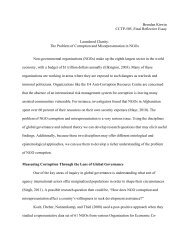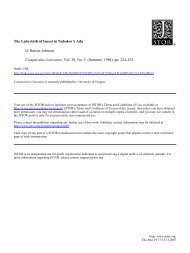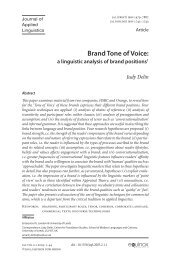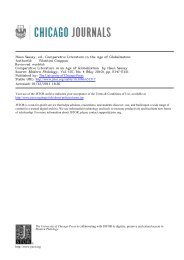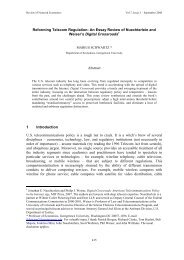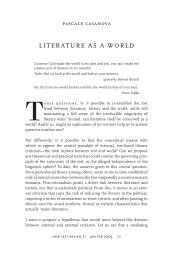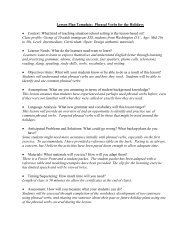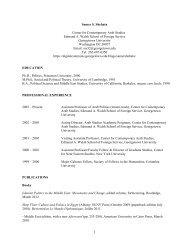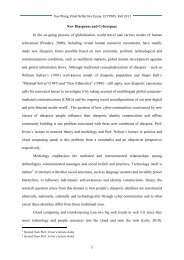roote-prokop-2013-g3-drosophila-genetics-training-all
roote-prokop-2013-g3-drosophila-genetics-training-all
roote-prokop-2013-g3-drosophila-genetics-training-all
You also want an ePaper? Increase the reach of your titles
YUMPU automatically turns print PDFs into web optimized ePapers that Google loves.
A. Prokop - A rough guide to Drosophila mating schemes 22<br />
Figure 16. Maternal gene product and germline clones<br />
A) Many genes are expressed in the female germline and gene product in the form of mRNA or protein<br />
(blue) is deposited in oocytes but not in sperm (white), often perduring into early embryonic stages or<br />
even larval stages and beyond (depending on the half life of the particular mRNA and/or protein). B) If<br />
mutant <strong>all</strong>eles of such genes are homozygous lethal, heterozygous parents (m/+) have to be used in<br />
crosses to generate homozygous mutant F1 individuals (m/m); these mutant individuals display maternal<br />
gene product (derived from their mother's wildtype copy of the gene) that may mask mutant phenotypes<br />
especi<strong>all</strong>y at earlier stages of development. C) Heterozygosis for ovo D causes cell-autonomous<br />
elimination of female germline cells; through FRT-mediated recombination in m/ovo D mothers,<br />
homozygous oocytes can be generated that are no longer eliminated and are the only eggs being laid by<br />
these females [57]. Homozygous mutant embryos developing from these eggs lack both maternal<br />
function and zygotic function, whereas heterozygous embryos display zygotic expression of the wildtype<br />
<strong>all</strong>ele starting earliest at ~3.5 hr after fertilisation at 25ºC (embryonic stage 8) [58].<br />
6. Classical strategies for the mapping of mutant <strong>all</strong>eles or transgenic constructs<br />
You may encounter situations in which the location of a mutant <strong>all</strong>ele or P-element insertion is not<br />
known, for example after having conducted a chemical or X-ray mutagenesis (Fig. 2) or when using<br />
a P-element line of unknown origin (unfortunately not a rare experience). To map such mutant<br />
<strong>all</strong>eles, a step-wise strategy can be applied to determine the chromosome, the region on the<br />
chromosome and, eventu<strong>all</strong>y, the actual gene locus. Nowadays, mapping can often be achieved by<br />
molecular strategies, such as plasmid rescue (Fig. 12 B), inverse or splinkerette PCR [59] or highthroughput<br />
genome sequencing [60]. However, classical genetic strategies remain important and<br />
are briefly summarised here.<br />
a. Determining the chromosome: You hold a viable P{lacZ,w + } line in the laboratory that serves<br />
as an excellent reporter for your tissue of interest, but it is not known on which chromosome<br />
the P-element is inserted. To determine the chromosome of insertion you can use a simple<br />
two-generation cross using a w - mutant double-balancer stock (Fig. 17).<br />
b. Meiotic mapping: During meiosis, recombination occurs between homologous chromosomes<br />
and the frequency of recombination between two loci on the same chromosome provides a<br />
measure of their distance apart (section 4.1.4). To make efficient use of this strategy, multi<br />
marker chromosomes have been generated that carry four or more marker mutations on<br />
the same chromosome (Bloomington / Mapping stocks / Meiotic mapping). Each marker<br />
provides an independent reference point, and they can be assessed jointly in the same set<br />
of crosses, thus informing you about the approximate location of your mutation [2,25]. Note<br />
that multi-marker chromosomes can also be used to generate recombinant chromosomes<br />
where other strategies might fail. For example, recombining a mutation onto a chromosome<br />
that already carries two or more mutations, or making recombinant chromosomes with<br />
homozygous viable mutations is made far easier with multi-marker chromosomes.<br />
c. Deletion mapping: Deficiencies are chromosomal aberrations in which genomic regions<br />
containing one, few or many genetic loci are deleted. Large collections of balanced<br />
deficiencies are available through stock centres (e.g. Bloomington / Deficiencies) and listed



